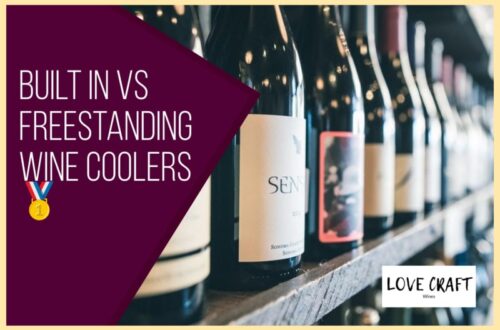Did you know that the material of your wine glass can actually enhance the taste and aroma of your wine? It’s true! According to a study conducted by the University of Cambridge, the material of your wine glass can significantly affect how you perceive the taste and aroma of your wine.
This means that choosing the right material for your wine glass is just as important as selecting the right wine for your occasion.
So, what materials are used to make wine glasses? Well, there are several options to choose from: crystal, lead-free crystal, glass, ceramics, and even plastic.
Each material has its own unique advantages and disadvantages, and selecting the right one can be a daunting task. But fear not, because in this article, we will explore the different materials used to make wine glasses, their pros and cons, and how to choose the perfect material for your wine type and occasion.
So sit back, pour yourself a glass of your favorite vintage, and let’s dive into the world of wine glass materials.
Table of Contents
The Role of Wine Glass Material in Enhancing Wine Taste
You’ll be surprised at how much the material of your wine glass can affect the taste and overall experience of drinking wine.
Wine chemistry plays a big role in the way wine tastes and feels in your mouth, and the material of the glass can either enhance or detract from those flavors and sensations.
Different materials have different effects on the wine, and it’s important to choose the right material based on the type of wine you’ll be drinking.
Sensory evaluation is an important part of wine tasting, and the material of the glass can have a big impact on the way the wine smells and tastes.
For example, a glass made from a thin, delicate material like crystal can enhance the aroma and flavor of the wine, while a glass made from thicker, heavier material can dull those same qualities.
Understanding the role of wine glass material in enhancing wine taste is essential for anyone who wants to enjoy their wine to the fullest.
Crystal Wine Glasses: Clarity, Brilliance, and Durability
If you’re looking for wine glasses that embody both clarity and durability, crystal wine glasses might just be the way to go – after all, the proof is in the pudding!
Crystal wine glasses are made using a specific manufacturing process that involves melting high-quality silica, lead oxide, and other minerals at extremely high temperatures. This process results in a glass that is not only beautiful, but also strong and resistant to breakage.
However, it’s important to note that crystal glassware requires a bit more TLC than other types of glasses. To maintain the clarity and brilliance of your crystal wine glasses, it’s crucial to avoid harsh detergents and abrasive sponges when cleaning them. Instead, use a soft cloth and mild dish soap.
Additionally, never put your crystal glasses in the dishwasher or stack them too tightly in your cupboard, as this can cause scratches or chips. By following these dos and don’ts, you can ensure that your crystal wine glasses will last for years to come.
Speaking of lasting for years, have you heard about lead-free crystal glasses, a healthier alternative?
Lead-Free Crystal Glasses: A Healthier Alternative
For those who prioritize health and safety, consider exploring lead-free crystal glasses as a potential option for your glassware collection. While traditional crystal glasses contain lead, which can leach into your wine and potentially harm your health, lead-free crystal glasses offer a safer alternative without sacrificing the clarity, brilliance, and durability of traditional crystal.
Additionally, lead-free crystal glasses are often considered more eco-friendly options, as they are typically made using a manufacturing process that is less harmful to the environment. Lead-free crystal glasses are made using a similar manufacturing process to traditional crystal glasses, but without the addition of lead. Instead, other minerals such as barium or potassium are used to achieve the same level of clarity and brilliance.
This makes lead-free crystal glasses a great option for those who are looking for a high-quality, beautiful glassware that is also safe for everyday use. So, if you’re looking for a safer and more eco-friendly option for your wine glasses, lead-free crystal glasses are definitely worth exploring.
Glass, Ceramics, and Plastic Wine Glasses: Advantages and Disadvantages
As you sip your favorite vintage, consider the advantages and disadvantages of glass, ceramics, and plastic for your stemware. Each has its unique qualities that can impact the overall experience of your wine.
Ceramic wine glasses are an eco-friendly option that can be made from natural materials like clay and sand. They’re also durable and can keep your wine at a consistent temperature. However, they’re heavier than other materials and can be more difficult to clean.
Acrylic wine glasses, on the other hand, are lightweight and shatterproof, making them perfect for outdoor events. They also come in a variety of colors and designs, adding a fun element to your drinking experience. However, they’re not as durable as glass or ceramic and can scratch easily.
Glass wine glasses are the classic choice and have been used for centuries. They’re elegant and allow for the true color and aromas of the wine to shine through. However, they’re fragile and can break easily, making them a potential safety hazard.
Choosing the Right Wine Glass Material for Your Wine Type and Occasion
Picking the ideal wine glass for your preferred type of vino and specific occasion is like finding a needle in a haystack, but with the right knowledge, you can make a sound decision.
Choosing the right wine glass material is important in enhancing the flavor, aroma, and overall experience of your wine. The most common material used in making wine glasses is glass. Glass wine glasses are perfect for those who want to showcase the wine’s color and clarity. They’re also easy to clean and maintain.
If you prefer a more elegant and delicate wine glass design, ceramics might be the perfect material for you. Ceramic wine glasses are known for their unique and creative designs that can add a touch of sophistication to any occasion.
On the other hand, if you’re looking for a more practical and cost-effective option, plastic wine glasses might be the way to go. They’re perfect for outdoor events, picnics, and other casual occasions.
Whatever material you choose, make sure to follow proper cleaning tips to keep your wine glasses in pristine condition and maximize their lifespan.
Frequently Asked Questions
How are wine glasses manufactured?
If you’re curious about how wine glasses are manufactured, there are two main methods: glass blowing and mold casting.
Glass blowing involves heating a glass tube and then blowing air into it to form a shape. This is a highly skilled process that requires years of training to master.
Mold casting, on the other hand, involves pouring molten glass into a mold and then allowing it to cool and harden. This method is more efficient and can produce a higher volume of glasses, but it lacks the artistry and personal touch of glass blowing.
Regardless of the method used, wine glasses are crafted with precision and care to ensure that they enhance the flavor and aroma of the wine they hold.
What is the history of wine glasses?
As you delve into the history of wine glasses, you’ll discover that the design of these elegant vessels has evolved over the centuries.
Wine glass design has come a long way from the early days when they were made of clay and lacked stems.
Today’s stemware is a work of art, with a graceful shape that enhances the color, aroma, and flavor of the wine.
The evolution of stemware is a fascinating journey that has seen the development of different styles, such as the Bordeaux, Burgundy, and flute glasses.
The intricate details of the glasses, from the thickness of the rim to the height of the stem, are all part of the design that makes drinking wine a sophisticated experience.
It’s like admiring a piece of fine art, where every detail has been thoughtfully considered.
Can wine glasses be recycled?
Recycling wine glasses is a great way to reduce the environmental impact of wine consumption. Most wine glasses are made from soda-lime glass, which is recyclable. This type of glass is made from sand, soda ash, and limestone.
However, not all glass recycling centers accept wine glasses due to their unique shape and thickness. It’s important to check with your local recycling center to see if they accept wine glasses. If they don’t, consider repurposing your wine glasses for another use or donating them to a thrift store.
By taking these steps, we can all do our part to reduce waste and protect the environment.
How do you properly clean and store wine glasses?
To ensure the longevity of your wine glasses, proper cleaning and storage techniques are crucial.
Start by hand washing your glasses with warm water and a mild detergent, avoiding harsh chemicals or abrasive sponges.
Rinse thoroughly and dry with a soft, lint-free cloth.
Store your glasses upright in a dry, dust-free area, preferably in a wine glass rack to prevent breakage.
Avoid stacking glasses or storing them upside down, as this can cause damage.
By taking the time to properly care for your wine glasses, you can increase their lifespan and prevent the need for frequent replacements.
Are there any cultural or regional differences in wine glass preferences?
When it comes to wine glass preferences, there are certainly cultural and regional differences to take into account.
For example, in Germany, the traditional wine glass shape is narrower and taller than those commonly used in the United States.
Additionally, the amount of wine poured into a glass can vary depending on where you are.
In Italy, for instance, it’s considered poor etiquette to fill a wine glass more than halfway, whereas in France, it’s customary to fill the glass nearly to the top.
Ultimately, the shape of the wine glass can affect the way the wine smells and tastes, so it’s important to choose the right glass for the occasion.
Knowing a bit about wine glass etiquette can also help you make a great impression at your next wine-tasting event or dinner party.
Conclusion
Congratulations! You’ve learned about the different materials used to make wine glasses and how they can affect the taste and overall experience of drinking wine.
Just like how the type of soil and climate affects the flavor of grapes, the material of the wine glass can also enhance or detract from the wine’s aroma, taste, and visual presentation.
Think of it like this – you wouldn’t wear hiking boots to a formal event, just like you wouldn’t serve a bold red wine in a delicate, thin glass.
Choosing the right wine glass material for your wine type and occasion is crucial in elevating your wine-drinking experience. So, whether you prefer crystal glasses for their clarity and durability or opt for lead-free options, make sure to choose a material that complements the wine’s characteristics and enhances its flavor and aroma.
Cheers to enjoying your favorite wine in the perfect glass!





